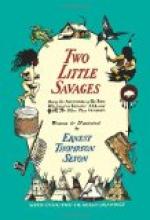“I want the Sioux style. We have copied their teepee and war bonnet—and the Sioux are the best Indians, anyway.”
“Or the worst, according to what side you’re on,” was Caleb’s reply. But he went on: “Sioux Injuns are Plains Injuns and wear a hard sole. Let’s see, now. I’ll cut you a pair.”
“No, make them for me. It’s my Horse,” said Guy.
“No, you don’t. Your Paw give that to me.” Caleb’s tone said plainly that Guy’s laziness had made a bad impression, so he had to stand aside while Yan was measured. Caleb had saved a part of the hide untanned though thoroughly cleaned. This was soaked in warm water till soft. Yan’s foot was placed on it and a line drawn around the foot for a guide; this when cut out made the sole of one moccasin (A, cut below), and by turning it underside up it served as pattern to cut the other.
Now Caleb measured the length of the foot and added one inch, and the width across the instep, adding half an inch, and with these as greatest length and breadth cut out a piece of soft leather (B). Then in this he made the cut a b on the middle line one way and c d on the middle line the other way. A second piece the reverse of this was cut, and next a piece of soft leather for inside tongue (C) was sewn to the large piece (B), so that the edge a b of C was fast to a b of B. A second piece was sewn to the other leather (B reversed).
“Them’s your vamps for uppers. Now’s the time to bead ’em if you want to.”
“Don’t know how.”
“Well, I can’t larn you that; that’s a woman’s work. But I kin show you the pattern of the first pair I ever wore; I ain’t likely to forget ’em, for I killed the Buffalo myself and seen the hull making.” He might have added that he subsequently married the squaw, but he did not.
“There’s about the style” [D]. “Them three-cornered red and white things all round is the hills where the moccasins was to carry me safely; on the heel is a little blue pathway with nothing in it: that is behind—it’s past. On the instep is three red, white and blue pathways where the moccasin was to take me: they’re ahead—in the future. Each path has lots of things in it, mostly changes and trails, an’ all three ends in an Eagle feather—that stands for an honour. Ye kin paint them that way after they’re made. Well, now, we’ll sew on the upper with a good thick strand of sinew in the needle—or if you have an awl you kin do without a needle on a pinch—and be sure to bring the stitches out the edge of the sole instead of right through, then they don’t wear off. That’s the way.” [E.]
So they worked away, clumsily, while Guy snickered and sizzled, and Sam suggested that Si Lee would make a better squaw than both of them.
The sole as well as the upper being quite soft allowed them to turn the moccasin inside out as often as they liked—and they did like; it seemed necessary to reverse it every few minutes. But at length the two pieces were fastened together all around, the seam gap at the heel was quickly sewn up, four pairs of lace holes were made (a, b, c, d, in D), and an eighteen-inch strip of soft leather run through them for a lace.




